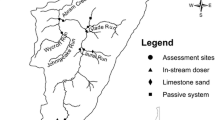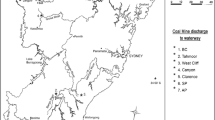Abstract
Acid mine drainage (AMD) often exerts various environmental pressures on nearby water courses: chemical stress from low pH and dissolved metals; physical stress from metal oxide deposits. Affected streams can thus display a spatially variable combination of stress agents that may complicate its biomonitoring using native communities such as periphyton. Here, we have measured water and periphyton variables in four streams that surround an abandoned copper mine to determine which periphyton attributes consistently detected AMD impact in a complex environmental setting. Seventeen years after the end of commercial exploitation, the abandoned mine still decreases water quality in nearby streams: moderate acidification, very high metal load (Al, Ni, Cu, Zn), and a conspicuous presence of metal oxide deposits with diverse composition. Even under the resultant complex pattern of polluted conditions, periphyton was a reliable bioindicator of AMD. Epilithic diatom taxa tolerant of acidic conditions increased in AMD sites and, at severely impacted locations, species richness decreased. Also, algal biomass may have been negatively affected in some stream reaches affected by metal oxide deposits. Other periphyton attributes (total biomass, diatom diversity) seemed mostly unrelated to AMD. Diatom assemblage composition was the most sensitive and consistent bioindicator of mine drainage; besides, it rendered a biological assessment of AMD impact that largely coincided with the physicochemical evaluation. Still, including other taxonomic (proportion of acid-tolerant diatom species, diatom richness) and non-taxonomic (algal biomass) attributes in the biomonitoring procedure rendered a more comprehensive assessment of the negative consequences generated by AMD.
Similar content being viewed by others
References
Alvarez, E., Pérez, A., & Calvo, R. (1993). Aluminium speciation in surface waters and soil solutions in areas of sulphide mineralization in Galicia (N.W.Spain). The Science of the Total Environment, 133, 17–37.
Archibald, R. E. M. (1972). Diversity in some South African diatom associations and its relation to water quality. Water Research, 6, 1229–1238.
Battarbee, R. W., Charles, D. F., Dixit, S. S., & Renberg, I. (1999). Diatoms as indicators of surface water acidity. In E. F. Stoermer, & J. P. Smol (Eds.) The Diatoms: Applications for the Environmental and Earth Sciences (pp. 85–127). Cambridge, UK: Cambridge University Press.
Calvo de Anta, R., & Pérez Otero, A. (1994). Soils affected by acid mine waters in Galicia (N.W. Spain). Water, Air, & Soil Pollution, 73, 247–263.
Clarke, K. R., & Ainsworth, M. (1993). A method of linking multivariate community structure to environmental variables. Marine Ecology—Progress Series, 92, 205–219.
Clements, W. H., Carlisle, D. M., Lazorchak, J. M., & Johnson, P. C. (2000). Heavy metals structure benthic communities in a Colorado mountain stream. Ecological Applications, 10, 626–638.
Coste, M., & Ector, L. (2000). Diatomées invasives exotiques ou rares en France: principales observations effectuées au cours des dernières décennies. Systematics and Geography of Plants, 70, 373–400.
Day, R. W., & Quinn, G. P. (1989). Comparisons of treatments after an analysis of variance in ecology. Ecological Monographs, 59, 433–463.
DeNicola, D. M. (2000). A review of diatoms found in highly acidic environments. Hydrobiologia, 433, 111–122.
DeNicola, D. M., & Stapleton, M. G. (2002). Impact of acid mine drainage on benthic communities in streams: the relative roles of substratum vs. aqueous effects. Environmental Pollution, 119, 303–315.
Deniseger, J., Austin, A., & Lucey, W. P. (1986). Periphyton communities in a pristine mountain stream above and below heavy metal mining operations. Freshwater Biology, 16, 209–218.
Elwood, J. W., & Mulholland, P. J. (1989). Effects of acidic precipitation on stream ecosystems. In D. C. Adriano, A. H. Johnson, & W. Salomons (Eds.) Acidic Precipitation, Biological and Ecological Effects (pp. 85–135). New York: Springer.
Genter, R. B. (1996). Ecotoxicology of inorganic chemical stress to algae. In R. J. Stevenson, M. L. Bothwell, & R. L. Lowe (Eds.) Algal Ecology: Freshwater benthic ecosystems (pp. 403–468). London: Academic.
Hargreaves, J. W., Lloyd, E. J. H., & Whitton, B. A. (1975). Chemistry and vegetation of highly acidic streams. Freshwater Biology, 5, 563–576.
Hill, B. H., Willingham, W. T., Parrish, L. P., & McFarland, B. H. (2000). Periphyton community responses to elevated metal concentrations in a Rocky Mountain stream. Hydrobiologia, 428, 161–169.
Hirst, H., Juttner, I., & Ormerod, S. J. (2002). Comparing the responses of diatoms and macroinvertebrates to metals in upland streams of Wales and Cornwall. Freshwater Biology, 47, 1752–1765.
Hirst, H., Chaud, F., Delabie, C., Juttner, I., & Ormerod, S. J. (2004). Assessing the short-term response of stream diatoms to acidity using inter-basin transplantations and chemical diffusing substrates. Freshwater Biology, 49, 1072–1088.
Iserentant, R., & Ector, L. (1996). Gomphonema rhombicum M. Schimidt (Bacillariophyta): Typification et description en microscopie optique. Bulletin Français de la Pêche et de la Pisciculture, 341–342, 115–124.
Jeffrey, S. W., & Humphrey, G. F. (1975). New spectrophotometric equations for determining chlorophylls a, b, c1 and c2 in higher-plants, algae and natural phytoplankton. Biochemie und Physiologie der Pflanzen, 167, 191–194.
Krammer, K., & Lange-Bertalot, H. (1986). Bacillariophyceae. Teil 1. Naviculaceae. Jena: Fischer.
Krammer, K., & Lange-Bertalot, H. (1988). Bacillariophyceae. Teil 2. Epithemiaceae, Bacillariophyceae, Surirellaceae. Jena: Fischer.
Krammer, K., & Lange-Bertalot, H. (1991a). Bacillariophyceae. Teil 3. Centrales, Fragilariaceae, Eunotiaceae. Jena: Fischer.
Krammer, K., & Lange-Bertalot, H. (1991b). Bacillariophyceae. Teil 4. Achnanthaceae, Kritische Ergänzungen zu Navicula (Lineolatae) und Gomphonema. Jena: Fischer.
Krammer, K., & Lange-Bertalot, H. (2000). Bacillariophyceae. Part 5. English and French Translations of the Keys. Jena: Fischer.
Kwandrans, J. (1993). Diatom communities of acidic mountain streams in Poland. Hydrobiologia, 269, 335–342.
Ledger, M., & Hildrew, A. G. (1998). Temporal and spatial variation in the epilithic biofilm of an acid stream. Freshwater Biology, 40, 655–670.
Lohr, A. J., Sluik, R., Olaveson, M. M., Ivorra, W., Van Gestel, C. A. M., & Van Straalen, N. M. (2006). Macroinvertebrate and algal communities in an extremely acidic river and the Kawah Ijen crater lake (pH<0.3), Indonesia. Archiv für Hydrobiologie, 165, 1–21.
Meegan, S. K., & Perry, S. A. (1996). Periphyton communities in headwater streams of different water chemistry in the central Appalachian Mountains. Journal of Freshwater Ecology, 11, 247–256.
Mulholland, P. J., Elwood, J. W., Palumbo, A. V., & Stevenson, R. J. (1986). Effect of stream acidification on periphyton composition, chlorophyll and productivity. Canadian Journal of Fisheries and Aquatic Sciences, 43, 1846–1858.
Niyogi, D. K., Mcknight, D. M., & Lewis, W. M. (1999). Influences of water and substrate quality for periphyton in a montane stream affected by acid-mine drainage. Limnology and Oceanography, 44, 804–809.
Niyogi, D. K., Lewis, W. M., & McKnight, D. M. (2002). Effects of stress from mine drainage on diversity, biomass, and function of primary producers in mountain streams. Ecosystems, 5, 554–567.
Oksanen, J., Kindt, R., Legendre, P., O’Hara, B., Henry, M., & Stevens, H. (2007). vegan: Community Ecology Package. R package version 1.8-8. http://cran.r-project.org/, http://r-forge.r-project.org/projects/vegan/.
Patrick, R. (1973). Use of algae, specially diatoms, in the assessment of water quality. In J. Cairns Jr., & K. L. Dickson (Eds.) Biological Methods for the Assessment of Water Quality (pp. 76–95). Philadelphia, PA: American Society for Testing and Materials.
Peakall, R., & Smouse, P. E. (2006). GENALEX 6: Genetic analysis in Excel. Population genetic software for teaching and research. Molecular Ecology Notes, 6, 288–295.
Planas, D. (1996). Acidification effects. In R. J. Stevenson, M. L. Bothwell, & R. L. Lowe (Eds.) Algal Ecology: Freshwater Benthic Ecosystems (pp. 497–530). London: Academic.
Quinn, G. P., & Keough, M. J. (2002). Experimental Design and Data Analysis for Biologists. Cambridge, UK: Cambridge University Press.
Sabater, S., & Admiraal, W. (2005). Periphyton as biological indicators in managed aquatic ecosystems. In M. E. Azim, M. C. J. Verdegem, A. A. van Dam, & M. C. M. Beveridge (Eds.) Periphyton: Ecology, Exploitation and Management (pp. 71–89). Cambridge, MA: CABI.
Sabater, S., Buchaca, T., Cambra, J., Catalan, J., Guasch, H., Ivorra, N., Munoz, I., Navarro, E., Real, M., & Romani, A. (2003). Structure and function of benthic algal communities in an extremely acid river. Journal of Phycology, 39, 481.
Steinman, A. D., & Lamberti, G. A. (1996). Biomass and pigments of benthic algae. In F. R. Hauer, & G. A. Lamberti (Eds.) Methods in Stream Ecology (pp. 295–313). San Diego, CA: Academic.
Stevenson, R. J., & Pan, Y. (1999). Assessing environmental conditions in rivers and streams with diatoms. In E. F. Stoermer, & J. P. Smol (Eds.) The Diatoms: Applications for the Environmental and Earth Sciences (pp. 11–40). Cambridge, UK: Cambridge University Press.
United States Environmental Protection Agency (2006). National Recommended Water Quality Criteria. (USEPA).
van Dam, H. (1984). A guide to the literature for the identification of freshwater diatoms in The Netherlands. Hydrobiological Bulletin, 18, 11–16.
van Dam, H., Mertens, A., & Sinkeldam, J. (1994). A coded checklist and ecological indicator values of freshwater diatoms from The Netherlands. Netherlands Journal of Aquatic Ecology, 28, 117–133.
Verb, R. G., & Vis, M. L. (2000). Comparison of benthic diatom assemblages from streams draining abandoned and reclaimed coal mines and nonimpacted sites. Journal of the North American Benthological Society, 19, 274–288.
Verb, R. G., & Vis, M. L. (2005). Periphyton assemblages as bioindicators of mine-drainage in unglaciated Western Allegheny plateau lotic systems. Water, Air, & Soil Pollution, 161, 227–265.
Warner, R. W. (1971). Distribution of biota in a stream polluted by acid mine-drainage. Ohio Journal of Science, 71, 202–215.
Weber, C. I. (1973). Biological Field and Laboratory Methods for Measuring the Quality of Surface Waters and Effluents. U.S. Environmental Protection Agency, Cincinnati: 4-73-001.
Whitton, B. A., & Diaz, B. M. (1981). Influence of environmental factors on photosynthetic species composition in highly acidic waters. Verhandlungen—Internationale Vereinigung fuer Theoretische und Angewandte Limnologie, 21, 1459–1465.
Whitton, B. A., & Kelly, M. G. (1995). Use of algae and other plants for monitoring rivers. Australian Journal of Ecology, 20, 45–56.
Author information
Authors and Affiliations
Corresponding author
Rights and permissions
About this article
Cite this article
de la Peña, S., Barreiro, R. Biomonitoring acidic drainage impact in a complex setting using periphyton. Environ Monit Assess 150, 351–363 (2009). https://doi.org/10.1007/s10661-008-0235-4
Received:
Accepted:
Published:
Issue Date:
DOI: https://doi.org/10.1007/s10661-008-0235-4




